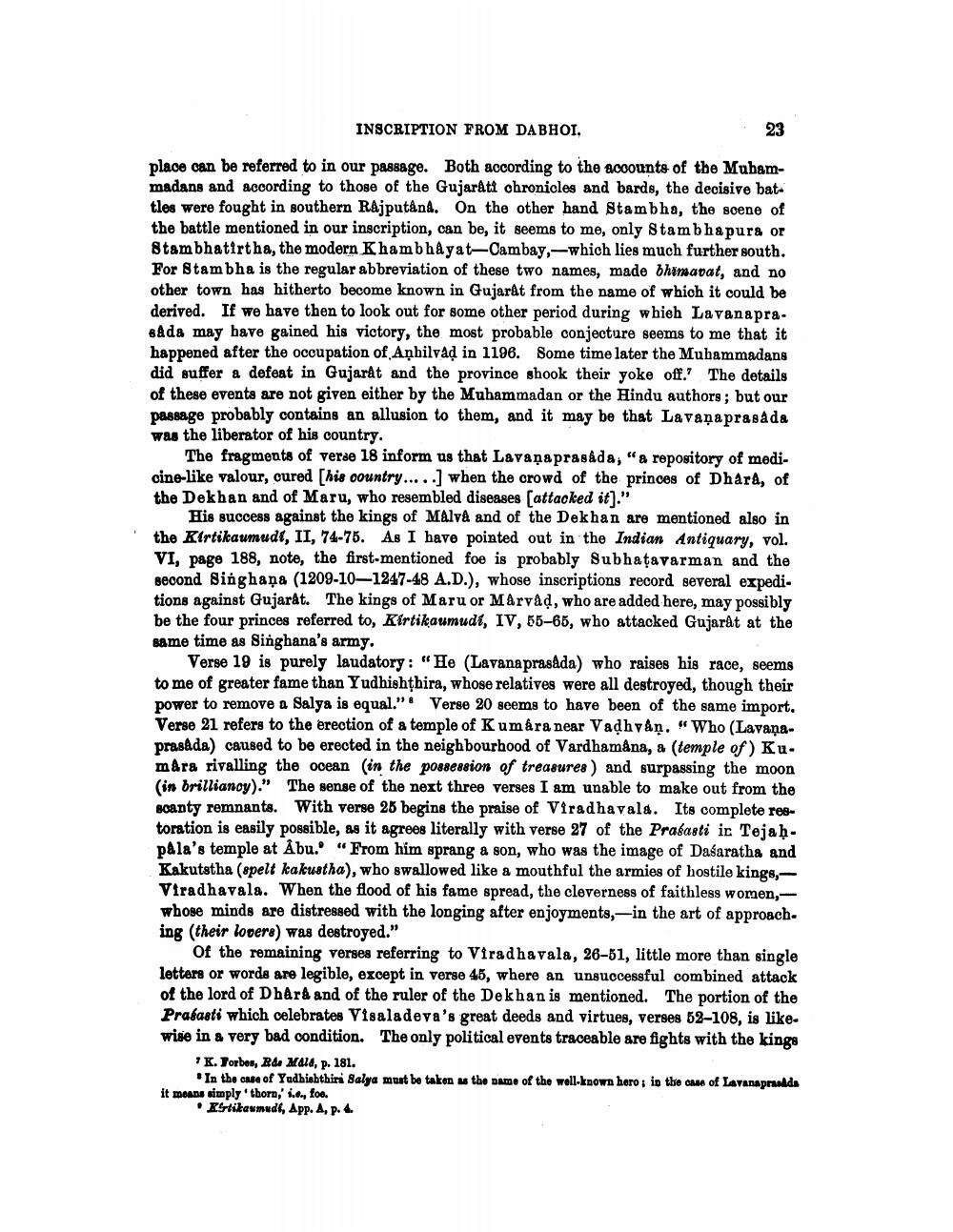________________
INSCRIPTION FROM DABHOI.
23
place can be referred to in our passage. Both according to the accounts of the Muhammadans and according to those of the Gujarati chronicles and bards, the decisive battles were fought in southern Rajputånd. On the other hand Stambha, the scene of the battle mentioned in our inscription, can be, it seems to me, only Stambhapura or 8tam bhatirtha, the modern Khambhayat-Cambay-which lies much further south. For Stam bha is the regular abbreviation of these two names, made bhinavat, and no other town has hitherto become known in Gujarat from the name of which it could be derived. If we have then to look out for some other period during which Lavanaprasåda may have gained his victory, the most probable conjecture seems to me that it happened after the occupation of Anbilvad in 1196. Some time later the Muhammadans did suffer a defeat in Gujarat and the province shook their yoke off. The details of these events are not given either by the Muhammadan or the Hindu authors; but our passage probably contains an allusion to them, and it may be that Lavaņaprasada was the liberator of his country.
The fragments of verse 18 inform us that Lavaņaprasada, "& repository of medicine-like valour, cured [his country.....] when the crowd of the princes of Dhara, of the Dekhan and of Maru, who resembled diseases [attacked it)."
His success against the kings of Malvå and of the Dekhan are mentioned also in the Kirtikaumudi, II, 74-75. As I have pointed out in the Indian Antiquary, vol. VI, page 188, note, the first-mentioned foe is probably Subhatavarman and the second Singhaņa (1209-10—1247-48 A.D.), whose inscriptions record several expeditions against Gujarat. The kings of Maru or Marvad, who are added here, may possibly be the four princes referred to, Kirtikaumudi, IV, 55-65, who attacked Gujarat at the same time as Singhana's army.
Verse 19 is purely laudatory: "He (Lavana prasada) who raises his race, seems to me of greater fame than Yudhishthira, whose relatives were all destroyed, though their power to remove a Salya is equal.". Verse 20 seems to have been of the same import. Verse 21 refers to the erection of a temple of Kumára near Vadhyán. "Who (Lavaņaprasada) caused to be erected in the neighbourhood of Vardhamana, a (temple of) Ku. mara rivalling the ocean in the possession of treasures and surpassing the moon
in brillianoy)." The sense of the next three verses I am unable to make out from the scanty remnants. With verse 25 begins the praise of Viradhavala. Its complete restoration is easily possible, as it agrees literally with verse 27 of the Prasasti ir Tejaḥ. pala's temple at Åbu. “From him sprang a son, who was the image of Dasaratha and Kakutstha (spelt kakustha), who swallowed like a mouthful the armies of hostile kingsViradhavala. When the flood of his fame spread, the cleverness of faithless women,whose minds are distressed with the longing after enjoyments,-in the art of approach. ing (their lovers) was destroyed."
Of the remaining verses referring to Viradhavala, 26-51, little more than single letters or words are legible, except in verse 45, where an unsuccessful combined attack of the lord of Dhard and of the ruler of the Dekhan is mentioned. The portion of the Prasasti which celebrates Visaladeva's great deeds and virtues, verses 52-108, is likewise in a very bad condition. The only political events traceable are fights with the kings
* K. Forbes, Rde Mald, p. 181.
In the case of Yudhishthiri Salya must be taken the name of the well-known hero; in the can of Lavanaprnalda it means simply thorn,' i..., foe.
Kirtikaumudi, App. 4, p. 4




